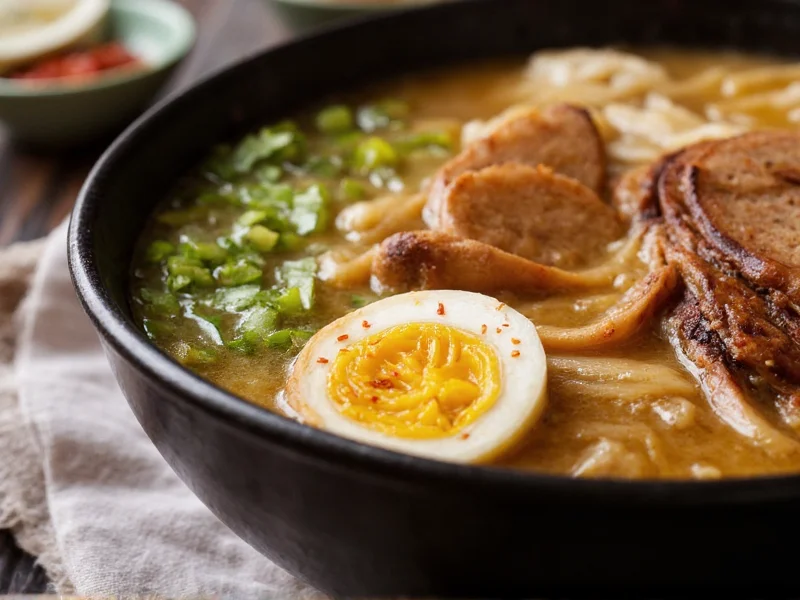Soba soup represents one of Japan's most cherished culinary traditions, offering a perfect harmony between simple ingredients and sophisticated flavors. Unlike many Western noodle soups, authentic soba soup centers around the delicate balance of dashi broth—typically made from kombu (kelp) and katsuobushi (dried bonito flakes)—that forms the foundation of Japanese cuisine. The buckwheat noodles themselves contain between 40-100% buckwheat flour, with higher percentages indicating more traditional preparation methods that require skilled handling due to buckwheat's lack of gluten.
The Cultural Significance of Soba in Japanese Tradition
In Japan, soba carries deep cultural meaning beyond mere sustenance. The practice of eating soba on New Year's Eve (toshikoshi soba) symbolizes longevity and cutting away misfortunes of the past year. This tradition dates back to the Edo period when soba's clean break when bitten represented severing bad luck. Soba restaurants (soba-ya) have served as community gathering places for centuries, with many establishments maintaining the same recipes for generations.
Essential Components of Authentic Soba Soup
Creating genuine soba soup requires understanding its fundamental elements:
| Component | Traditional Ingredients | Modern Variations |
|---|---|---|
| Broth (Dashi) | Kombu, katsuobushi, sometimes niboshi (dried sardines) | Shiitake mushrooms, instant dashi powder |
| Noodles | 100% buckwheat or 80% buckwheat/20% wheat blend | Pre-packaged noodles with lower buckwheat content |
| Seasoning | Mirin, soy sauce, salt | Additional spices like ginger or chili |
| Toppings | Green onions, nori, tempura bits, kamaboko | Boiled eggs, mushrooms, spinach |
Hot vs Cold Soba Soup: Understanding the Distinctions
While many Western diners associate soba exclusively with hot soup, Japan recognizes two primary serving styles:
- Kake soba - The hot soup version served in steaming dashi broth, typically enjoyed during winter months. The broth temperature must be carefully controlled—too hot and it overcooks the delicate noodles.
- Zaru soba - The cold version served with noodles on a bamboo tray alongside a concentrated dipping sauce (tsuyu). This summer preparation highlights the clean flavor of high-quality buckwheat.
Understanding these variations helps appreciate why soba soup remains versatile across seasons. The hot preparation provides comforting warmth while preserving the distinctive nutty flavor of buckwheat, whereas cold soba showcases the noodle's texture and purity.
Nutritional Profile and Health Considerations
Soba soup offers notable nutritional advantages compared to other noodle dishes. Buckwheat contains all nine essential amino acids, making it a complete protein source rare among plant foods. A typical serving of soba soup (without heavy toppings) provides:
- Approximately 200-250 calories per bowl
- 8-10 grams of protein
- Significant amounts of magnesium, manganese, and fiber
- Lower glycemic index than wheat-based noodles
Research indicates that buckwheat consumption may support cardiovascular health and blood sugar regulation. However, those with celiac disease should verify that the soba contains 100% buckwheat, as many commercial varieties blend in wheat flour.
Distinguishing Soba from Other Japanese Noodle Soups
Many diners confuse Japan's noodle varieties, but key differences exist between soba soup and similar dishes:
- Soba vs Ramen - Ramen uses wheat noodles in a pork- or chicken-based broth, often with higher fat content and more complex seasoning. Soba's broth remains lighter with dashi as the foundation.
- Soba vs Udon - Udon features thick wheat noodles in a milder broth, creating a heartier, chewier experience compared to soba's delicate texture.
- Soba vs Somen - Somen are thin wheat noodles typically served cold, lacking buckwheat's distinctive flavor profile.
These distinctions matter when seeking authentic Japanese dining experiences or attempting traditional preparation methods at home. Understanding what makes soba soup unique helps appreciate its proper preparation and consumption.
Common Misconceptions About Soba Soup
Several misunderstandings persist about this traditional dish:
- Misconception: All soba noodles contain only buckwheat
Reality: Most commercial soba contains 20-60% wheat flour to improve texture and cooking properties. - Misconception: Soba soup broth is similar to miso soup
Reality: Authentic soba broth uses clear dashi, while miso soup features fermented soybean paste. - Misconception: Soba is primarily a cold dish
Reality: Hot soba soup (kake soba) represents one of Japan's most common comfort foods during colder months.
Experiencing Authentic Soba Soup
To truly appreciate soba soup, understanding proper consumption etiquette enhances the experience. In traditional settings, diners often slurp the noodles—a practice that aerates the noodles and enhances flavor perception. The dipping sauce for cold soba should be mixed with green onions and wasabi at the table, never pre-mixed. When ordering at authentic establishments, look for shops that make noodles in-house, as freshly prepared soba offers superior texture and flavor compared to pre-packaged alternatives.











 浙公网安备
33010002000092号
浙公网安备
33010002000092号 浙B2-20120091-4
浙B2-20120091-4